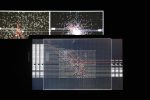Digby Warde-Aldam on the best and worst art that London has to offer
Biennale time is fast approaching, and my inbox won’t let me forget it. I’m stuck here in London for the duration, and am starting to feel more than a little provincial. I can’t shake the sense that owing to Biennale-fever, London has temporarily become a cultural backwater. If proof were needed, the most significant exhibitions to open in this country in the past fortnight have been not in the capital, but in East Anglia.
I’m referring, of course, to the Gaudier-Brzeska show at Kettle’s Yard, Cambridge (until 21 June) and the Sainsbury Centre’s ‘Francis Bacon and the Masters’ (until 26 July). At the time of writing, I have yet to visit either – and have discovered precious little in London to make up for it.
◎
On the other hand, I have had some very welcome blasts from the past. First, there was Ryoji Ikeda’s supersymmetry at the Vinyl Factory’s space above the Brewer Street NCP car park (until 31 May). The Japanese composer and artist is best known over here for Spectra, the light installation set up at the Houses of Parliament last year to commemorate the First World War. I first encountered his work five years ago, when I was an intern at a truly hopeless art centre in the suburbs of Paris.
The only good memory I have of the place is helping to set up Ikeda’s Test Pattern No.3, a project that was less a work of art than an exercise in sensory deprivation. It involved blinding, flashing strobes, white noise and randomly-generated blackouts. Weirdly, it also seemed to provoke total euphoria in all who were exposed to it. My retinas have never been quite the same since.
Supersymmetry is less full-on, but just as astonishing. Two banks of TV monitors – 40 of them! – beep and hum with intricate, flowing digital patterns, while clouds of data shoot across two enormous screens on either side. It draws on his interest in quantum physics (Ikeda has just ended a stint as artist-in-residence at CERN), and pulls off the weird feat of being both comforting and supremely alienating. Whichever side you swing to, it’s utterly hypnotic.
◎
I was thrilled to see Suzanne Treister featured in the calendar for the fig-2 programme at the ICA (hers was installation 14 of 50, from 6–12 April). Her Hexen 2.0 project is a bewildering investigation into technology, ideology and the occult. It’s hard to look at Treister’s extraordinary mind-maps without feeling just a little paranoid – but don’t, whatever you do, accuse her of being a conspiracy theorist.
Finally, there is ‘speculative sculptor’ Lawrence Lek, who I met two years ago when he debuted his interactive work Bonus Levels at the White Building in Hackney. His work stood out as imaginative then, but I had no idea quite how broad his ambitions were. Now, Lek has won this year’s ‘Converse x Dazed Emerging Artists Award’ award, a junket funded by the hipster bible Dazed & Confused and hosted by the Royal Academy (until 17 May).
Lek’s winning entry, Untitled, is a dizzyingly accurate virtual recreation of the Academy, transplanted from staid Mayfair to a wild, Ballardian tropical island. A voiceover reads an interview with a socialite from Russian Tatler, and the total absence of life and art in the building is haunting.
It’s a stunning practical achievement on its own, and an intelligent meditation on the financial tightropes institutions like the Academy must inevitably walk. Lek might laugh me down, but I thought it was a work of unusual political prescience. In the next fortnight, it is sadly probable that for whoever does cobble together a government, the arts will not be a priority. Quite how severe the cuts will be, one doesn’t dare imagine.
◎
Which brings me to a nostalgic conclusion. Under New Labour, ‘public sculpture’ was shorthand for the patronising dross that filled up our city centres. Now that the budget has shrivelled up, it seems that property developers have taken up the ugly sculpture brief.
I have just returned from a walk up Hammersmith riverside, on which I encountered a truly terrifying example. She towered above me, a 10-foot tall Amazon flasher with mirrors for skin, gratuitously baring all to the suburbs on the opposite bank. Surely nobody would be tasteless enough to commission such a horror in this day and age, I thought. But then I looked at the inscription: ‘RICK KIRBY: FIGUREHEAD’, I read on; ‘COMMISSIONED BY ST GEORGE PLC, APRIL 2014’. I have only one response – God help us.
Related Articles
What to see at the Venice Biennale
Gallery: ‘Lights Out’ commemorates First World War centenary
Fig-2 at the ICA: a rehashed pop-up exhibition that somehow works
Post-Surveillance: Suzanne Treister’s riposte to ‘Post-Internet’ art
Editor’s Letter: Will any UK politicians speak up about culture?






